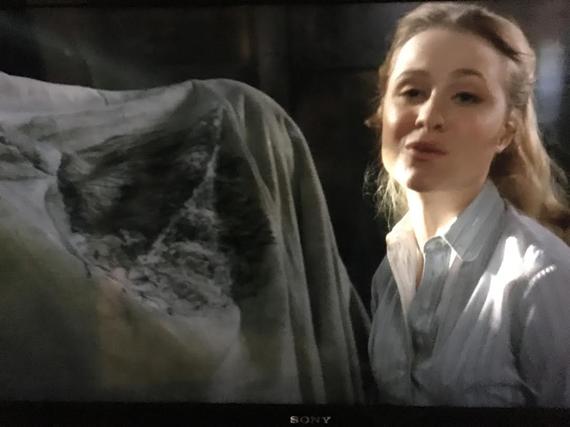HBO's remarkable series Westworld revolves in part around a character called Dolores who--spoiler alert--is slowly discovering her soul. In the most recent episode, viewers witness this growth through Dolores's art. From the beginning of the series, the character has painted landscapes--realistic, representational, traditional oil paintings of the scenery laid out before her. Now she has evolved to paint what she sees in her imagination, what she feels in her soul, and it looks barely like anything anyone but Dolores would recognize.
I "majored," in a way, in art from middle school through high school. I can't expect most people to understand, but being a gay teen in a public Virginia school was something between a war zone and a prison. Art class was a reprieve.
I began to draw in middle school: I usually finished my reading assignments and quizzes ahead of most of the rest of the class, and with time to kill I picked up a "How to Draw Horses" book that the teacher made available. I learned basic shapes and how they fit together. In art classes, I experimented with various mediums, always representationally. I drew, painted, or sculpted what my eyes saw: even when my class was challenged to create pastiches of one of Cezanne's Mount St. Victoire exercises in early cubism, I did so, but I simply painted what I saw. I was, as the cliche goes, inside the box of my own perceptions. Like Dolores in Westworld, I didn't even know anything existed beyond that box. That is, until I encountered Tori Amos's mind-scrambling album Boys for Pele.
Sarah Quigley, a redheaded acquaintance from years of art classes, told me to listen to Tori Amos during high school. She was forceful about it, almost as if she were trying to recruit me: You have to listen to her, she urged. You will love her. Sarah was one of a small handful of peers in high school who treated me as a human being--a shoutout to James Colvin, who always did, as well--and so when I saw that Tori Amos was performing on Saturday Night Live one night I watched my TV with eager curiosity. Amos played her then-new single "Caught a Lite Sneeze," pounding out dark, woody, springy notes on a harpsichord (a harpsichord?!) while emitting stratospheric vocals made of senseless words. I was baffled. I wondered if it was a joke of some sort, if it was supposed to have been funny. I reported back to Sarah on Monday--I remember my words--Tori Amos is a freak who can play a piano. Sarah was disappointed that I didn't give her a chance. I didn't get it.
A while later, around three o'clock in the morning, I was in the hazy daze of the witching hour and Amos's "Hey Jupiter" video came on VH1. It captivated me. The lyrics made so much more sense than the "Caught a Lite Sneeze" lyrics. Was this woman--her already prominent nose and almost unbelievably huge lips exaggerated by Kevin Aucoin's dramatic makeup application, surrounded by fire and strobing police lights--actually singing, "are you gay, are you blue"?
This was 1996. I was gay. The word gay was almost never said on television, except in the context of AIDS on news programming. There I was in the middle of the night, alone in silence, and this woman was asking if I was gay--yes--if I was blue--yes. "Thought we both could use a friend to turn to," Amos sang mournfully.
I worked at Blockbuster Video at the time, and I bought Boys for Pele from the display rack. (Blockbuster Video sold CDs!). I brought my discman into the bathroom with me and listened in the tub, my safe place. With "Hey Jupiter's" chorus in my head, I advanced straight to that track. The song was entirely different than the video version. The music video is set to an electronic drum loop; the album version only features two instruments: Amos's spare piano composition and her incomprehensibly soulful voice. The beauty of that voice conjured blood red satin ribbons in my mind as Amos sang her chorus--yet the song seemed lifeless. It felt like a bait and switch. So I decided to listen to the album from the beginning.
"Beauty Queen/Horses"--huh? I had never in my life listened to music that was not played in regular rotation on the radio. This song, to me, wasn't even something I would have called a song. It was...I couldn't have come up with a word at the time if you asked me. This went on for song after song; "Marianne," like several other songs, had a gorgeous sound, so, so beautiful, but it opens this way: "tuna/rubber/a little blubber in my igloo, yes." What?
Amos rebelliously terrifying her minister father with a seductive, profane, and (if you can accept it) a humorously insane performance of "Father Lucifer."
Of all the songs, the most confusing was one called "Father Lucifer." The sonic appeal was undeniable: Lush, baroque, lively and bright piano notes seduced me--successfully--as Amos sang "Father Lucifer/You never looked so sane...Nothing's gonna stop me/From floating." I had never once attended a church service in my lifetime, and had never been inside of a church other than for weddings and funerals--but this song terrified me. I didn't know what it was about, and the juxtaposition of beautiful and innocent melody, instrumentation, and vocals with profane lyrics freaked me out as I lay vulnerable in the bathtub. During the song's bridge, Amos layers on three different sets of lyrics sung in three different melodies, all of them seeming nonsense ("Every day's my wedding day/Though baby's still in his comatose state/I dye my own Easter eggs/Just don't go back, don't go"). All these contradictory and inexplicable things happening at once was too much to make sense of. More than that, it felt threatening for reasons I couldn't understand. I felt like I was being drawn into the mind of a person with schizophrenia, where everything was fractured and fragmented, partly coherent and beautiful and partly like a terrifying demonic possession and unnatural disorderliness.
I almost threw the album away, but because I had paid hard-earned money for it (Blockbuster Video was the worst employer.) I simply set it aside and expected never to listen again.
About six months later, out of the blue, I was haunted by the melodies of "Hey Jupiter" and "Father Lucifer."
By now, high school was behind me. A whole new life had emerged, a safer one in which I was no longer living in fear of my own nature and, most especially, how people might react to it. I had begun a long process of accepting myself and the life I was given, and I was ready to fight for my right to be that person and live that life. I think, in a way, I went back to Boys for Pele to find out how strong I was, if I could stand up spiritually to its threatening disorientation.
Oh, my God. How had I missed "Little Amsterdam" the first time around? What a brilliant, brilliant song. How had I missed the whimsical, wicked humor "In the Springtime of His Voodoo" ("Got an angry snatch/Girls you know what I mean/When swiveling that hip/Doesn't do the trick/Me, pureed sanitarily/Mr. Sulu, warp speed/Warp speed! Warp speed!") or allowed myself to receive the clear communication of Amos's voice and vocalizations of, yes, obtuse but poetic lyrics in "Putting the Damage On" ("Does anyone know why/You play with an orange rind?/You say you packed my things/And divided what was mine/You're off to the mountaintop/I say her skinny legs could use sun...I'm trying not to move/It's just your ghost passing through") and "The Doughnut Song" ("And Southern men can grow cold/Can grow purdy/Blood can be purdy/Like a delicate man/Copper to steel to a hinge/That is faltered/Two suns too many/Too many able fires").
The second time around, after my subconscious had integrated whatever it was that Amos was doing on this album, I was eager to take it in. How in the world, I wondered, can one human being have so many talents? Even though I couldn't make any sense of most of her lyrics, the sheer use of language was striking and profoundly moving. The way she gave voice to them was--I can say it now--spiritually evocative. Her piano! The depth and range of her voice, and her willingness to sacrifice its (in my mind) unparalleled beauty to make it as raw and scratched and damaged and even ugly as required by the spirit of each song. What the hell was this?
In short, what I am saying is that Boys for Pele is what awoke me, after seriously studying art from middle school through high school, to art. To what I just saw Dolores experience on Westworld: Not replication of sensory perceptions, but fearless conveyance of soulfulness, which is necessarily ugly and sometimes impossible to understand or to explain in any reasonable or rational way. Experiencing it can be inexplicably threatening, eliciting reactions of terror and disgust at times.
It is because of Boys for Pele that I paint what I feel, and what I see in my mind's eye as much as what my physical eyes see. More notably, it's because of Boys for Pele that I chose to study writing, and it is because of this album that I write honestly, about myself and about the world. Making oneself vulnerable is always fear inducing, but Amos bore her raw soul on this album and being exposed to that transformed me into a fuller human being, and certainly a more accepting one. Every courageous thing I have done as an adult has been done in part because of the effect of this album. That has to read as hyperbole. It's not.

Confirmed: Westworld's Dolores creates a non-realistic, non-representational, patently unbeautiful painting--it comes from deep inside her and is something only she truly understands. When asked what the painting is, Dolores answers, "I don't know. At home, I used to paint landscapes mostly but I was always just copying what I saw in the world outside me. This morning, I woke up and I thought, what if I drew something new? I imagine something beautiful..." It is art, and it confirms that Dolores has an imagination--and a soul.
Tori Amos, unlike any artist I have ever encountered, accesses and channels this confused, equally beautiful and disturbing and mostly in ways that defy explanation, other-dimensional reality. And she does it best on the album Boys for Pele.
After I had nearly worn through the CD from repeat listens, I bought Amos's previous two albums, Little Earthquakes and Under the Pink, and despite their friendliness to my ears and superiority to most other music I had known, they felt less honest and certainly less soul-revealing than Boys for Pele.
Today, Tori Amos released a 20th anniversary reissue of Boys for Pele. The album is remastered and comes packaged with a collection of B-sides from the Pele era, including the Dakota mix of "Hey Jupiter" (the version used for the hypnotic music video) and weird little delights that give me joy like "That's What I Like Mick (The Sandwich Song)." The album is worth buying because all of the music--with the exception of a couple of remixes that made the dance charts--is genre-defying art. But for me, the original album even after 20 years of expanded horizons and occasional apologias from Amos herself, dismissing the album as something of a failure necessary to her musical development, is perfect. It's absolutely perfect, as overlong and confused and baffling as parts of it remain. Boys for Pele introduced me to real art, and it stands on its own as a misunderstood and far too-little-appreciated (even by its own creator) masterpiece.
I'm not pitting female musicians or any musicians against one another when I say this, but I've never been able to get out of my mind the critical acclaim that was heaped on Taylor Swift--who BuzzFeed measured against Amos--by countless critics for these lyrics from her song "All Too Well":
'Cause there we are again in the middle of the night.
We dance around the kitchen in the refrigerator light
Down the stairs, I was there, I remember it all too well, yeah.
I don't know how many album reviews I read that praised those lines for being so brilliantly evocative. This was years ago, and all I could think was, "what is wrong with you people? Where were you when Boys for Pele came out? Where were you when Tori Amos was pouring these words from her soul":
Sometimes I breathe you in
And I know you know
And sometimes you take a swim
Found your writing on my wall
Left my heart soaking wet
Boy, your boots can leave a messThought I knew myself so well
All the dolls I had
Took my leather off the shelf
Your apocalypse was fab
For a girl who couldn't choose
Between a shower or a bath
And I thought I wouldn't have to be
With you
A magazine
Tori Amos's Boys for Pele is one of the most challenging and befuddling albums ever to have made the Billboard charts. (It made number two on the Billboard 200 when it was released--an incredible feat for an album built made with harpsichords and hybridized Southern gothic, Baroque, pop and alternative genres.) It is unquestionably relegated to a couple subsets of Generation X listeners--women, gay men and some Nirvana fans unafraid of accessing their emotional sides--but it is a singularly brilliant album, in my mind equivalent of Picasso's "Les Demoiselles D'Avignon" painting: Obviously Picasso, not quite like anything he or anyone else ever did before, threatening to audiences but undeniably from another realm and undeniably a catalyst for influencing a world of artists who have followed.
If you don't know Boys for Pele, get the album and give it many chances. (You may hate it at first listen. That's OK.) It changed my life and it could very well change yours.

